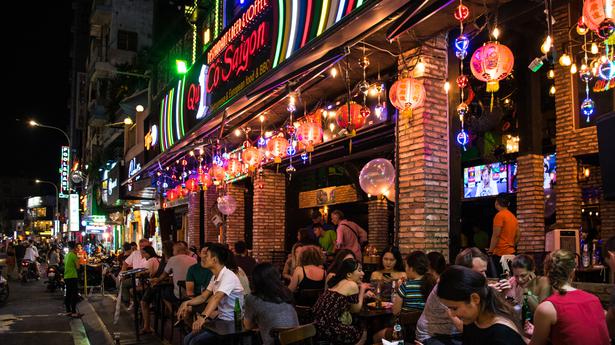A place with a definitive French flair like no other, it’s one of the first destinations of my ‘revenge travel’ series
A place with a definitive French flair like no other, it’s one of the first destinations of my ‘revenge travel’ series
One of those indelible legacies the pandemic has bestowed upon me — besides the heightened sense of anxiety and a borderline pathological cleanliness OCD — is a mild gluten intolerance. “ Anathema to an itinerant food and travel writer,” one might say. An emphatic “ no big deal” is what I’m known to shoot that down with these days. There’s a gluten-free alternative to just about anything edible. Yes, even good old beer!
But long before the culinary world sought out such benign alternatives to cater to us gluten-challenged souls, the Vietnamese had an ace up their sleeves for a whole other set of reasons. But more on that a little later.
I find myself in Vietnam these days. It’s one of the first destinations of my ‘revenge travel’ series that I’ve planned for the next couple of months. A place with a definitive French flair like no other.
As one might know, from 1887 until the Geneva Accord of 1954, Vietnam was part of French ‘Indochine’, a vast colonial stronghold which also included Laos and Cambodia. Even now, almost 70 years later, it’s easy to find French influences throughout the region, albeit with a few twists.
Women cook and sell banh mi sandwiches on the streets of Ho Chi Minh City.
| Photo Credit: Getty Images
For instance, my quotidian breakfast staple is a yummy, toasted bánh mi sandwich. A mini baguette-like sandwich stuffed with a curious assortment of French fillings and condiments like roast pork, pork pâté, and mayonnaise that pair superbly with typically Asian ones like sweet chilli sauce and fresh coriander fronds.
Airy and porous
But it’s the crusty baguette that puts it all into better perspective for me. What started off as regular-sized French baguette made with de rigueur wheat flour at the beginning of the colonial rule morphed into the mini gluten-free Vietnamese style bread made using rice flour (a South East Asian staple) — imparting the bread with a more airy and porous texture like never before.
There are French-style bakeries throughout Vietnam, serving not just the bánh mi in its various permutations and combinations, but also the beloved French coffee. Another surprise in the otherwise tea-obsessed continent.
Also distinct from its other, immediate South East Asian neighbours is the modern day Vietnamese script. This one with its base in the Roman script was promoted by the French colonial authorities after it was created by Alexandre de Rhodes, a Jesuit missionary.
The Notre-Dame Cathedral Basilica of Saigon is based architecturally on Paris’s hallowed Notre Dame.
| Photo Credit: Wiki Commons
Religion too — and more specifically Roman Catholic architecture — is another vestige of the French past. With their soaring arches, opera house-like balconies and grand columns, some of the most beautiful buildings are the churches I find in the country’s capital Hanoi and its commercial capital Ho Chi Minh City. From the St. Joseph’s Cathedral in Hanoi to the Notre-Dame Cathedral Basilica of Saigon, both are based architecturally on Paris’s hallowed Notre Dame.
But Catholicism isn’t the only organised form of religion the Vietnamese co-opted from the French. I’m talking about perhaps the least known religion in the world. One called Caodaism that I chance upon as I journey south along this narrow strip of a country.
Founded in southern Vietnam in 1926, Caodaism is a monotheistic religion that’s a curious amalgamation of various philosophies. With the word “ cao” meaning “high” and “ dai” meaning “peace”, its underpinnings are a fusion of the secular and religious philosophies of the East and the West. Interestingly, its tenets are also based on certain codes believed to be revealed to the religion’s founder Ngo Van Chieu, who was a district head of the French administration in Vietnam, via a series of séance messages starting from 1921.
Worshippers at a Cao Dai temple in southern Vietnam‘s Tây Ninh province, known as the birthplace of Caodaism.
| Photo Credit: Getty Images
Said to have over 4.4 million practicing Caodaists, it is Vietnam’s third largest religion after Buddhism and Roman Catholicism. What’s truly novel about Caodaism is that it combines elements from many of the world’s major religions, including Buddhism, Confucianism, Christianity, Hinduism, Islam, Judaism, Taoism, as well as Jainism!
Historical personalities
Another fascinating aspect of Caodaism is that among its pantheon of saints, historical personalities (mostly French, no surprise!) such as Joan of Arc and Louis Pasteur too find firm footing. But the most prominent and revered of them all is Victor Hugo since he gave many teachings and also the text of a number of important prayers to Caodaism.
In fact, it is said that he even predicted that he would become the prophet of a new religion to merge European and Asian mysticism. Philosophical foresight at its best, no?
The Mumbai-based writer and restaurant reviewer is passionate about food, travel and luxury, not necessarily in that order.
Stay connected with us on social media platform for instant update click here to join our Twitter, & Facebook
We are now on Telegram. Click here to join our channel (@TechiUpdate) and stay updated with the latest Technology headlines.
For all the latest Food and Drinks News Click Here

